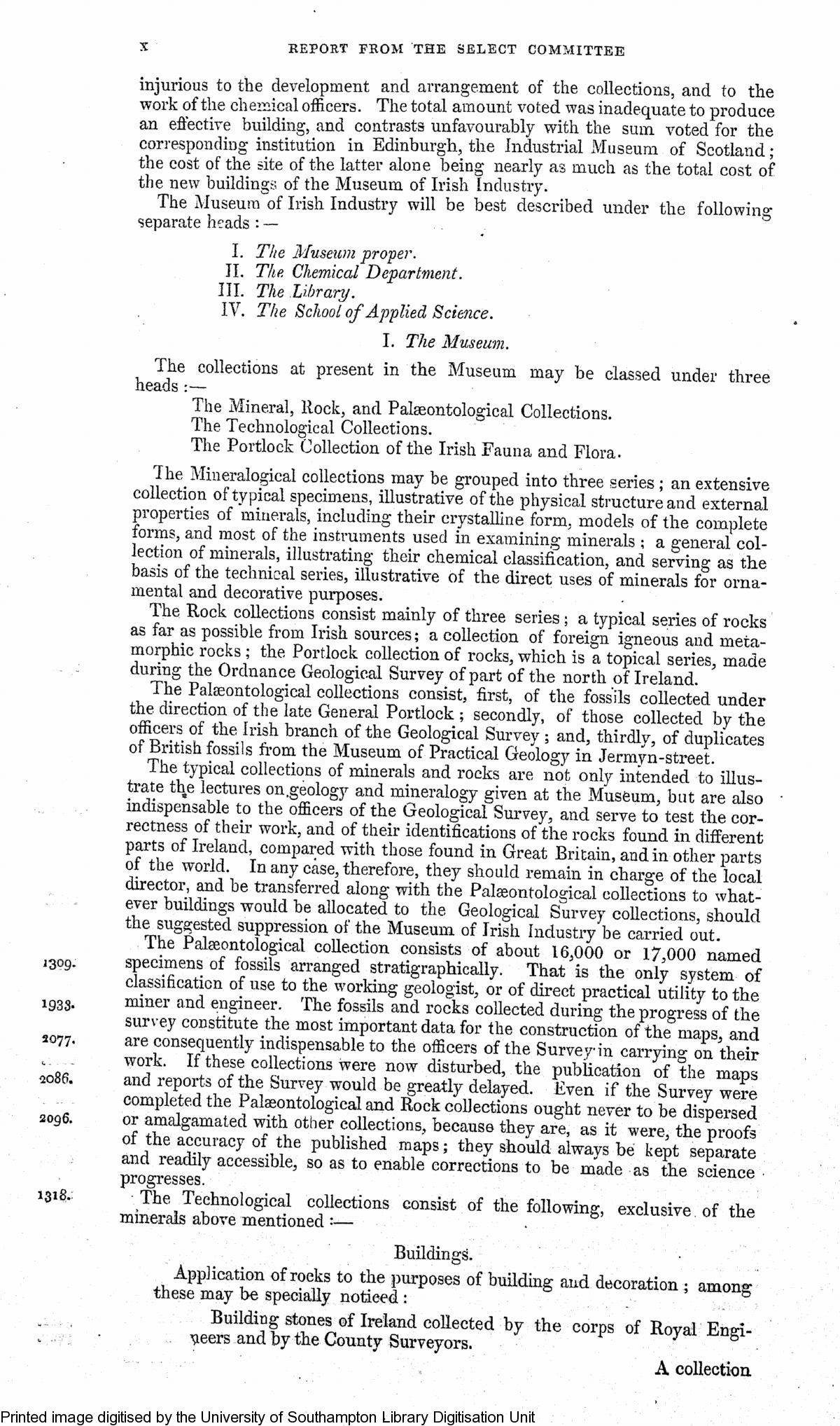X REPORT FROM THE SELECT COMMITTEE injurious to the development and arrangement of the collections, and to the work of the chemical officers.
The total amount voted was inadequate to produce an effective building, and contrasts unfavourably with the sum voted for the corresponding institution in Edinburgh, the Industrial Museum of Scotland ; the cost of the site of the latter alone being nearly as much as the total cost of the new buildings of the Museum of Irish Industry.
The Museum'of Irish Industry will be best described under the following separate heads : —
I.
The Museum proper.
11.
The Chemical Department.
III.
The Library.
IV.
The School of Applied Science.
I.
The Museum.
The collections at present in the Museum may be classed under three heads :—
The Mineral, Rock, and Palseontological Collections.
The Technological Collections.
The Portlock Collection of the Irish Fauna and Flora.
The Mineralogical collections may be grouped into three series ; an extensive collection of typical specimens, illustrative of the physical structure and external properties of minerals, including their crystalline form, models of the complete forms, and most of the instruments used in examining minerals ; a general col¬ lection of minerals, illustrating their chemical classification, and serving as the basis of the technical series, illustrative of the direct uses of minerals for orna¬ mental and decorative purposes.
The Rock collections consist mainly of three series ; a typical series of rocks as far as possible from Irish sources; a collection of foreign igneous and mera-morphic rocks ; the Portlock collection of rocks, which is a topical series, made during the Ordnance Geological Survey of part of the north of Ireland.
The Palseontological collections consist, first, of the fossils collected under the direction of the late General Portlock ; secondly, of those collected by the officers of the Irish branch of the Geological Survey; and, thirdly, of duplicates of British fossils from the Museum of Practical Geology in Jermyn-street.
The typical collections of minerals and rocks are not only intended to illus¬ trate the lectures on.geology
and mineralogy given at the Museum, but are also indispensable to the officers of the Geological Survey, and serve to test the cor¬ rectness of their work, and of their identifications of the rocks found in different parts of Ireland, compared with those found in Great Britain, and in other parts of the world.
In any case, therefore, they should remain in charge of the local director, and be transferred along with the Palasontological collections to what¬ ever buildings would be allocated to the Geological Survey collections, should the suggested suppression of the Museum of Irish industry be carried out.
The Palseontological collection consists of about 16,000 or 173000 named 1309.
specimens of fossils arranged stratigraphically.
That is the only system of classification of use to the working geologist, or of direct practical utility to the i933.
miner and engineer.
The fossils and rocks collected during the progress of the
survey constitute the most important data for the construction of the maps, and 2077.
are consequently indispensable to the officers of the Survey* in carrying on their work.
If these collections were now disturbed, the publication of the maps 2086.
and reports of the Survey would be greatly delayed.
Even if the Survey were completed the Palaeontological and Rock collections ought never to be dispersed 2096.
or amalgamated with other collections, because they are, as it were, the proofs of the accuracy of the published maps; they should always be kept separate and readily accessible, so as to enable corrections to be made as the science progresses.
1318.
The Technological collections consist of the following, exclusive of the minerals above mentioned :—
Buildings.
Application of rocks to the purposes of building and decoration ; among these may be specially notieed :
Building stones of Ireland collected by the corps of Royal Engi¬ neers and by the County Surveyors.
A collection

